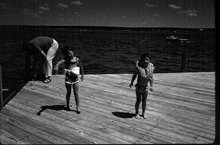
At Deweys (Panorama with tripod and cut negatives) October 7, 1949
“What the Photograph reproduces to infinity has occurred only once: the Photograph mechanically repeats what could never be repeated existentially. In the Photograph, the event is never transcended for something else: the Photograph always leads the corpus I need back to the body I see; it is the absolute particular, the sovereign Contingency, matte and somehow stupid, the This…in short, what Lacan calls the Tuché, the Occasion, the Encounter, the Real, in its indefatigable expression.” --Barthes, Camera Lucida
Barthes, apparently, was not dealing with negatives, but with the final prints that the artists themselves sought to frame for public view. With the negative, there are no finite encounters. There is a unique existential experience for an infinity of effects, an exponential derivation from the fundamental source: the negative.
This image (At Dewey’s) is really a beautiful negative that would not scan well, but I took a liking to the vague ghostliness of it--perhaps only made possible by my knowledge of the extent of information that the negative itself contains--it’s the “tip of the iceburg” theory of writing, but we all are only ever the tips of iceburgs, no?--I will upload the “true” image in the future, and then you will know as much as I do, about this negative, the old juniper--about my grandfather.
We are in what we see, what we choose to privilege. My grandfather and his father loved the math of photography--each print inscribed with meticulous calculations of exposure to light and printing technique. I have great respect for this, but no patience for it. I have studied the processes of the photographers that I am in awe of, most singularly Ansel Adams and Weston and Stieglitz (the incomparable Sudek). The old techniques, the large, thick silver gelatin through which light would filter, leaving a path of image in its wake, seems sculptural almost, intimate and physical--and dangerous. What have we traded that for? Immediacy and transience and sterility.
There was an exhibit last year at the Ransom Center, “The Image Wrought” which featured contemporary photographers who were experimenting with “archaic" techniques: “Photographers are using 19th-century processes to reassert the hand of the artist to photography. Wrought from silver, gold, mercury and iron, the resulting images have a strong physicality and presence.”
Yes.



